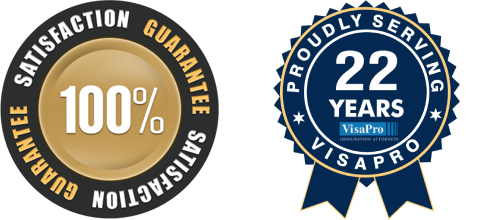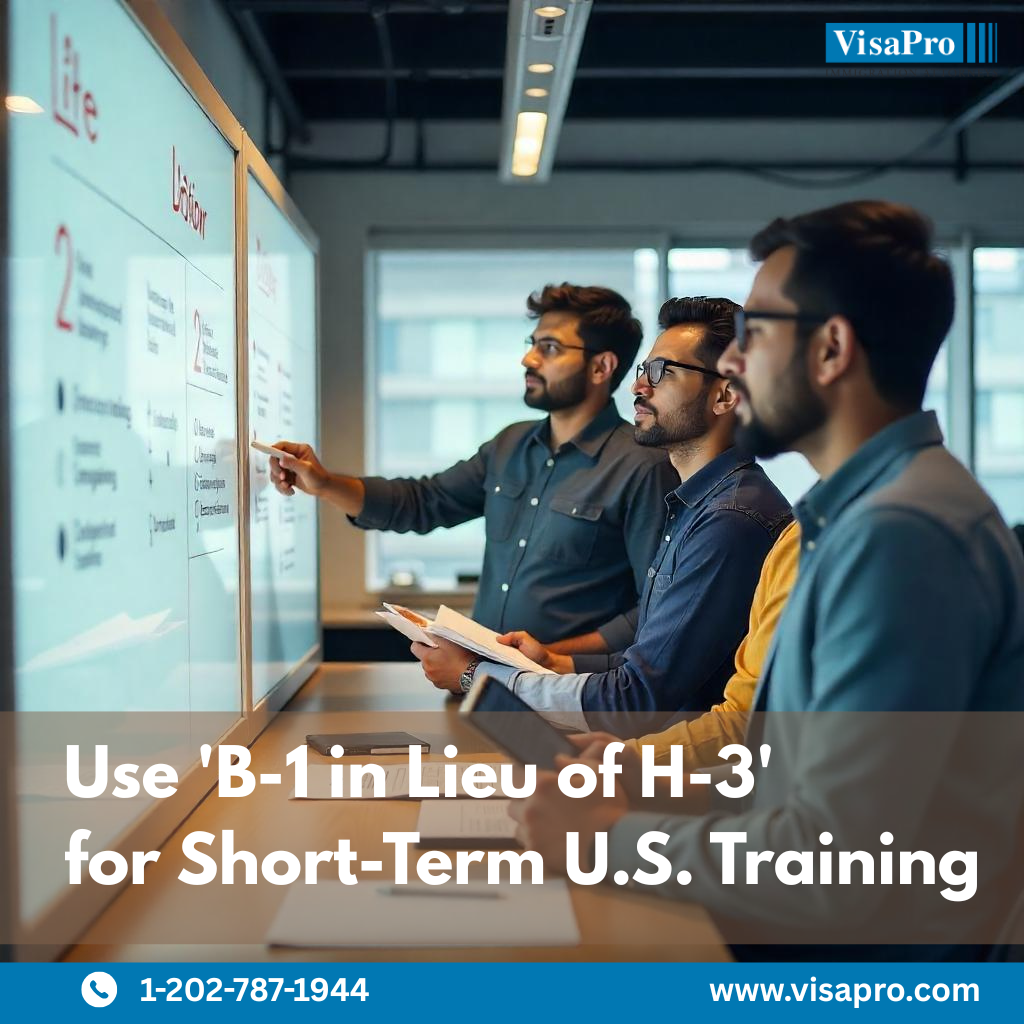Quick Summary:
If you’re building a software business and want to rotate Indian team members to the U.S. for training or development, you’re not alone. In this article, we’ll walk you through exactly how to structure your company and legally bring employees for short-term training or longer work assignments using B-1 in lieu of H-3, H-3, and L-1 visas, with practical steps, real examples, and actionable insights.
Understanding Your Options To Legally Bring Your India-Based Programmers To The U.S. For Training
Yes, you can rotate Indian team members to the U.S. for training, but only if done through the proper visa channels and corporate structure.
To do this efficiently and legally, it’s crucial to set up a U.S. company. This structure enables you to access multiple visa pathways, such as B-1 in lieu of H-3, H-3 trainee visa, and L-1 visa, to support your long-term growth vision.
Many tech entrepreneurs face a similar challenge: they’ve filed a patent, are commercializing a product, and want to scale their India-based workforce with on-the-ground training in the U.S. But bringing foreign nationals, even your own trusted programmers, for hands-on U.S. training without the right visa can lead to serious immigration violations. Let’s walk through the smart, legal pathways available.
Why Setting Up A U.S. Company With An Indian Subsidiary Is Your First Step
You must establish a qualifying relationship between your U.S. and Indian entities to unlock visa options like L-1 and H-3.
Without this structure, you lose access to key immigration pathways and risk running afoul of U.S. immigration law.
For business owners like you with a growing development team overseas and a need for cross-border collaboration, setting up a U.S. parent company and an Indian subsidiary is not just good practice, it’s essential. This structure proves the “qualifying relationship” that U.S. Citizenship and Immigration Services (USCIS) looks for in L-1 and may also be useful for H-3 visa petitions.
Tip:
- Set up a Delaware C-Corp or LLC in the U.S., depending on your long-term business goals and funding plans.
- Use this U.S. entity to sponsor visas and issue paychecks for U.S.-based employment.
- Ensure that your Indian company operates as a subsidiary, with common ownership or control to establish eligibility for multinational visa programs.
Using The B-1 in Lieu of H-3 Visa For Short-Term Training in the U.S.
The B-1 in lieu of H-3 visa allows Indian programmers to temporarily visit the U.S. for short-term training, without working or receiving a U.S. salary.
This visa category is ideal for rotating team members for up to 6 months of hands-on exposure before returning to train others in India.
This is the most flexible short-term option if your programmers don’t need to engage in productive work but simply receive training. It’s also a great tool when you’re just beginning to scale and need to onboard new hires or align your India-based team with the U.S. development roadmap.
Real-Life Example:
A U.S.-based startup with 2 engineers in California and 10 in Bengaluru used B-1 in lieu of H-3 to bring 3 team leads to the U.S. for 3 months of product training, enabling them to return and ramp up hiring and onboarding back in India. No salary was paid from the U.S., and no productive work was done on-site – just training.
Checklist To Qualify:
- The trainee remains employed and paid by the Indian entity
- The training is short-term and clearly documented
- No hands-on work or service is performed for the U.S. company
- The training cannot be available in India
Important Note:
Visa officers may apply strict scrutiny, and consular officers in India vary in how they apply B-1 in lieu of H-3. Documentation and legal strategy are critical.

When To Use The H-3 Trainee Visa For Longer-Term U.S. Training Assignments
The H-3 trainee visa is used when short-term B-1 training isn’t enough, especially when your training program requires several months and structured curriculum.
Unlike the B-1 in lieu of H-3, the H-3 visa allows a stay of up to 2 years and is more formalized.
If you’re building a training program that takes several months or involves technical systems, software architecture, or company-specific product orientation, the H-3 visa is your go-to.
H-3 visa is a nonimmigrant visa that allows foreign nationals to come to the U.S. for training not available in their home country. This is different from work. It must be structured as training only.
H-3 Visa Requirements Include:
- The training is not available in the home country
- The trainee will not displace U.S. workers
- The training does not primarily benefit the U.S. company
- The petition includes a detailed training plan
Example:
An AI software firm used the H-3 visa to bring 5 machine learning engineers from Hyderabad for a 10-month proprietary systems training in Austin. They later returned to scale the India team to 40 engineers using the acquired knowledge.
Tip:
Submit a detailed H-3 training program document with a clear curriculum, goals, and rotation plan. Avoid vague or boilerplate plans.
Leveraging The L-1 Visa To Build Long-Term U.S. Operations And Transfer Key Talent
The L-1 visa allows you to transfer managers or employees with specialized knowledge from your Indian subsidiary to your U.S. company.
This is ideal if your product is launching soon and you need key personnel on-site for extended assignments.
If your Indian team has engineers with deep expertise in the software or proprietary systems you’re building, they may qualify under L-1B Specialized Knowledge. Managers or senior team leads may qualify under L-1A Multinational Manager or Executive.
Key L-1 Eligibility Rules:
- Employee must have worked for the Indian company for at least 1 year in the past 3 years
- The U.S. and Indian entities must have a qualifying corporate relationship
- For L-1B, the knowledge should preferably be proprietary and/or company-specific
- For L-1A, the role must involve managing people, processes, or functions
Example:
A Miami-based startup filed L-1A for its Indian Head of Product to set up and manage a U.S. development team. They later used L-1B to bring 2 engineers with proprietary algorithm knowledge to support product customization.
Important Note:
L-1 petitions are increasingly scrutinized. The more established your India operations, the stronger your case, especially if the product is patent-pending and has proprietary architecture.
Structuring A Smart Immigration Timeline For Growth Over 2–3 Years
Plan visa rotations and scaling in stages, based on training goals, staffing needs, and immigration requirements.
Don’t try to bring everyone at once. Use short-term visas now, build U.S. operations slowly, and transition to L-1s as your structure matures.
| Year | Actions |
|---|---|
| Year 1 | Establish U.S. entity, use B-1 in lieu of H-3 for 1–3 programmers to visit for short-term training |
| Year 1–2 | Design a formal training program, apply for H-3 for 3–5 engineers |
| Year 2 | Apply for L-1 for core team members with specialized knowledge |
| Year 3 | Establish permanent U.S. workforce (4–5 people), with rotating India-based support |
| Year 3+ | Explore H-1B or green card options for key hires if needed |
Tip:
Use B-1 in lieu of H-3 and H-3 visa strategically to train multiple trainers over time. These trainers can then expand your India-based team to 50+ as planned.
Common Pitfalls To Avoid When Rotating International Teams To The U.S.
Failure to use proper visa channels can result in denials, deportation, or long-term immigration bars.
Even well-meaning entrepreneurs sometimes risk it by bringing foreign employees on ESTA or regular B-1 without proper intent.
Avoid These Mistakes:
- Trying to use visitor visas for programming work
- Having U.S. payroll issue salaries before proper visa approval
- Failing to prove the training is unavailable in India for the H-3
- Overstaying authorized visa duration
Checklist Before Sending Your Team:
- Do you have a U.S. entity established?
- Is the Indian employee currently employed and paid in India?
- Do you have a clear, non-work training plan?
- Are you prepared to document every step to USCIS or consular officers?
VisaPro’s expert immigration attorneys can help you build the right visa roadmap and avoid costly missteps.
FAQs: Visa Options For Rotating International Tech Teams To The U.S.
1.What is the B-1 in lieu of H-3 visa, and how is it used?
The B-1 in lieu of H-3 allows foreign employees to visit the U.S. for short-term training that doesn’t involve productive work. Each stay is restricted for up to 6 months and must involve training unavailable in their home country.
2.How is an H-3 visa useful for my Indian software engineers?
The H-3 visa allows your employees to receive structured training in the U.S. for up to 2 years, ideal if your U.S. company has formal training goals and a curriculum designed to be unavailable in India.
3.What are the H-3 visa requirements?
Key requirements include a qualifying U.S. company, a detailed training plan, proof that the training isn’t available in India, and assurance that the trainee won’t engage in work or displace U.S. workers.
4.Can I bring someone on H-3 and later transition to L-1?
Yes, if they meet the L-1 criteria after working at your Indian office for at least 1 year in the past 3, they may be eligible to transfer to your U.S. office under L-1.
Need Help Creating Your Visa Strategy?
VisaPro has helped hundreds of entrepreneurs like you bring overseas teams to the U.S. without visa headaches or legal trouble. Whether you’re exploring short-term training or long-term expansion, we’ll help you do it right.
👉 Schedule Your Free Visa Strategy Session With VisaPro
What VisaPro Customers Are Saying
The US [B-1] Visa has always been a tough ride, and being denied a few times it makes it even worse. But thanks to VisaPro and their meticulous processing I was granted a Visa. I would like to thank you and all the people involved in making this a success. I would like to recommend VisaPro to all those who seek peace of mind and hassle free Visa processing.”




 Manas Bhat, Director Operations, First Houston Mortgage India
Manas Bhat, Director Operations, First Houston Mortgage India